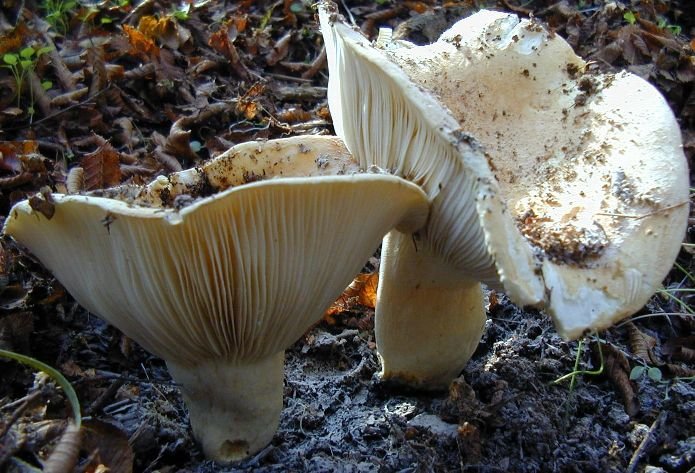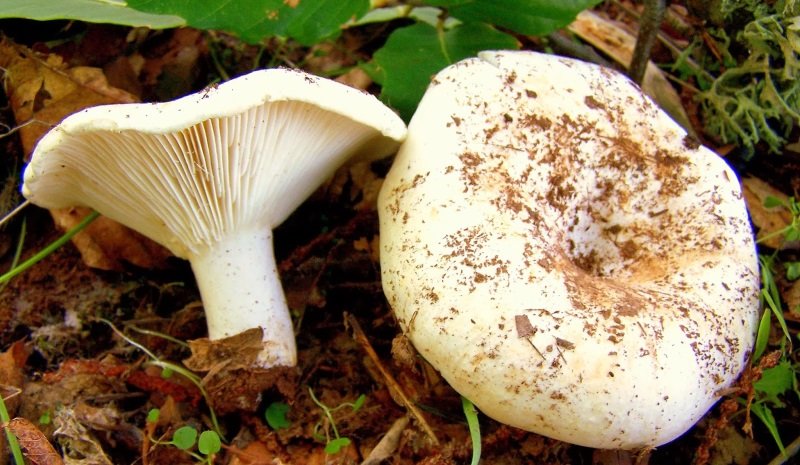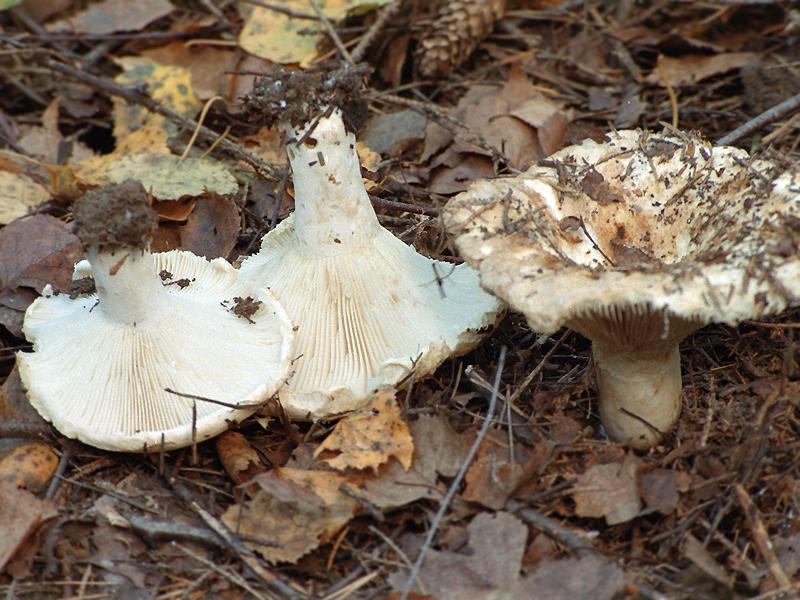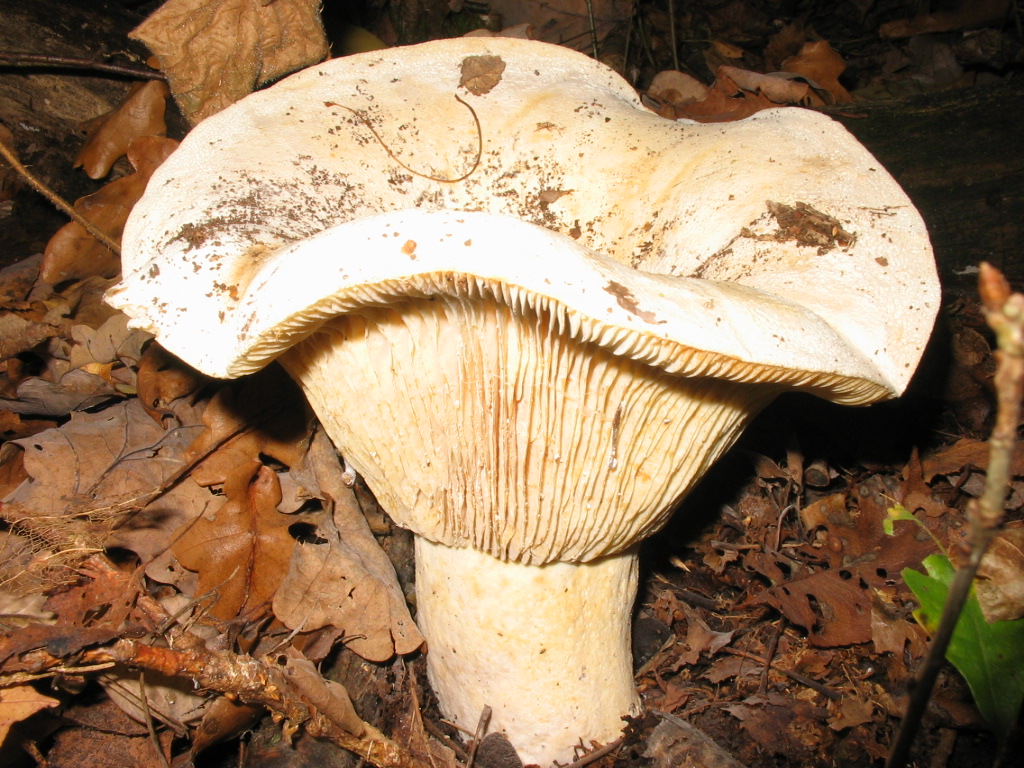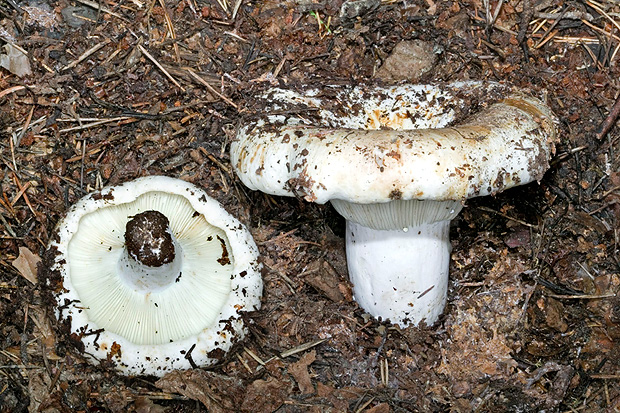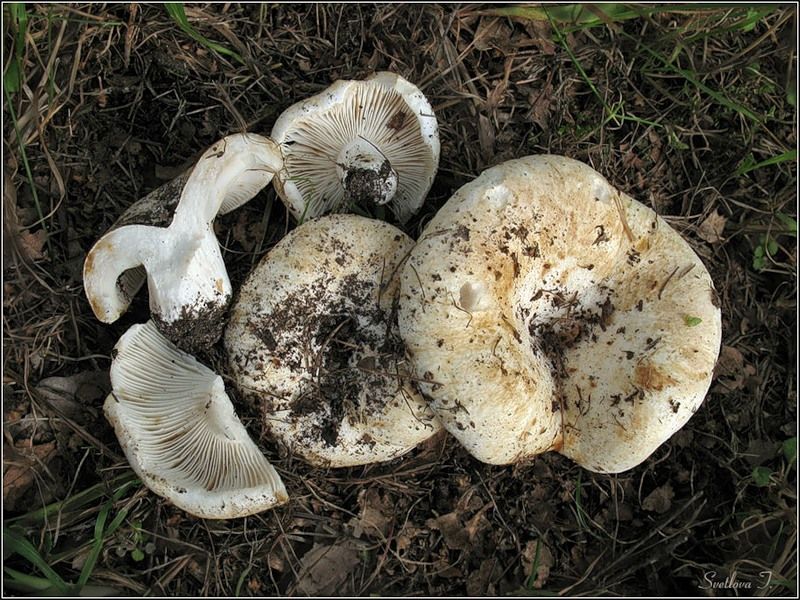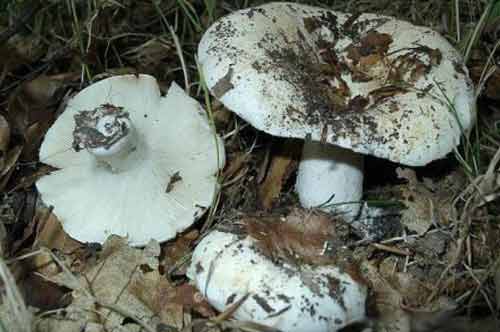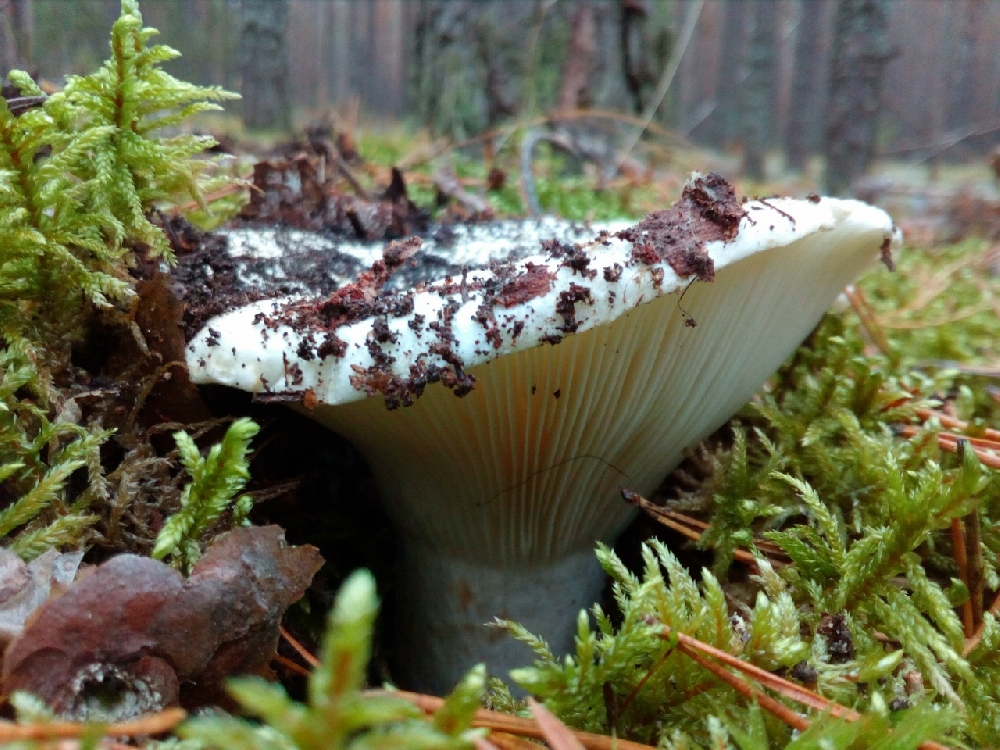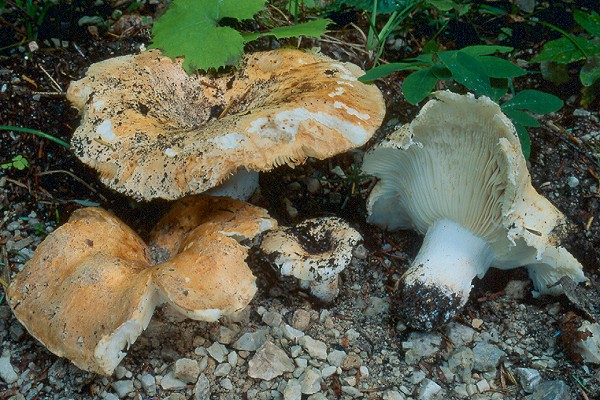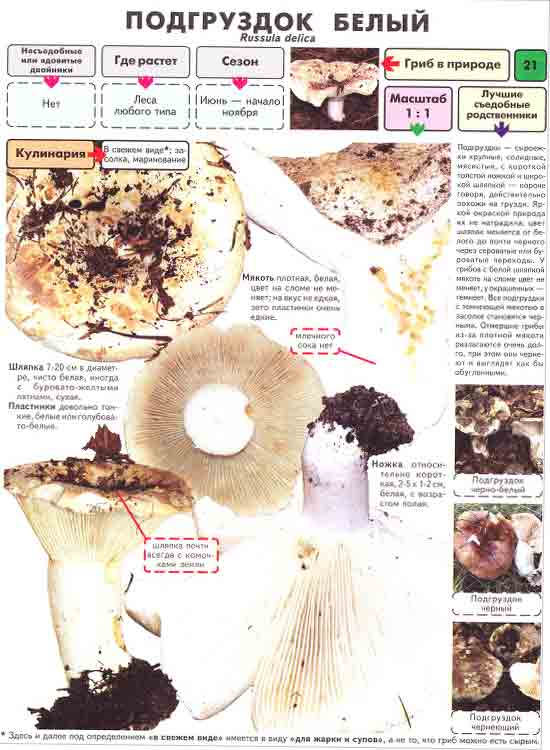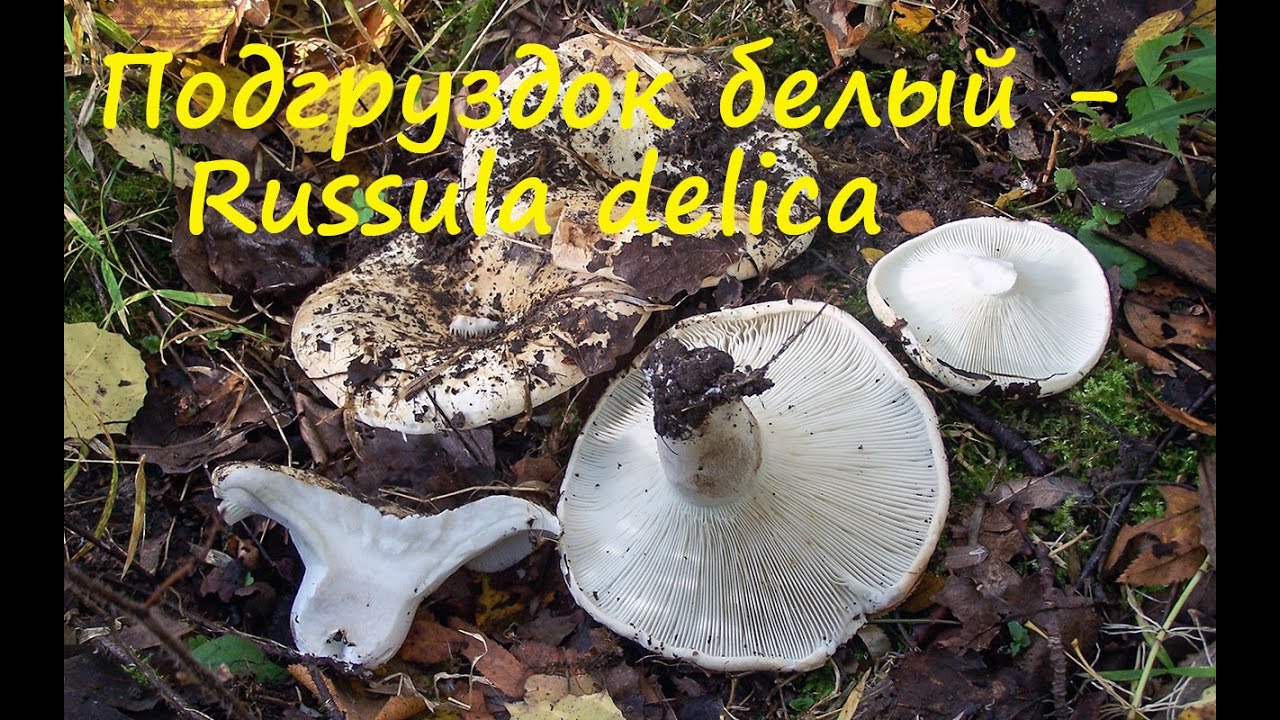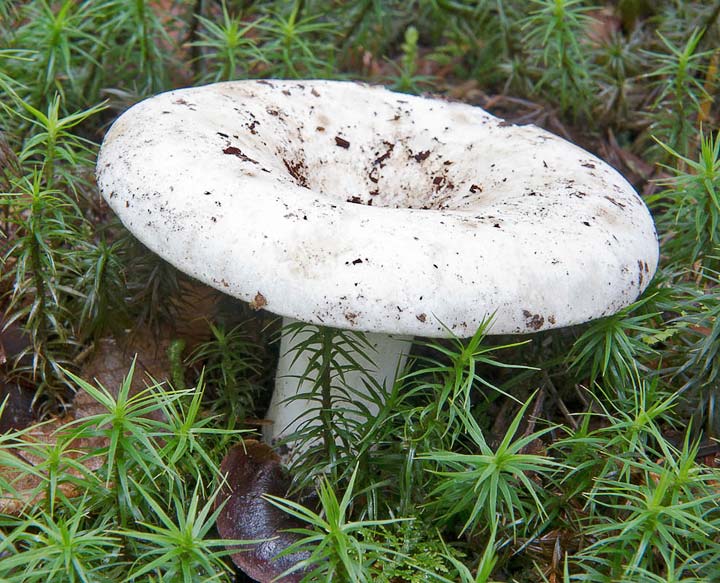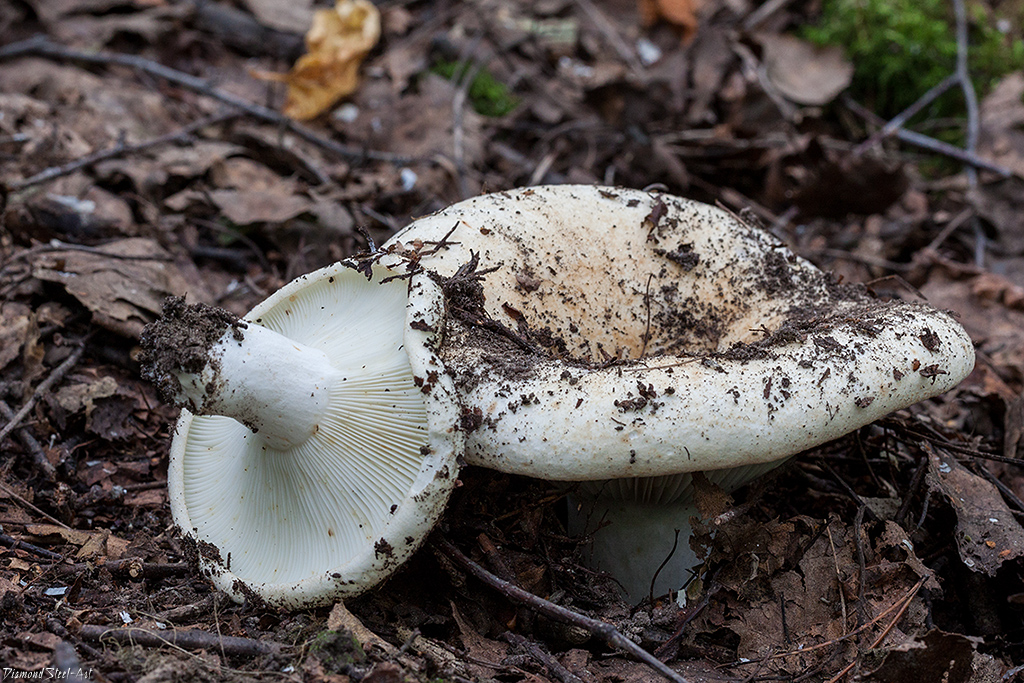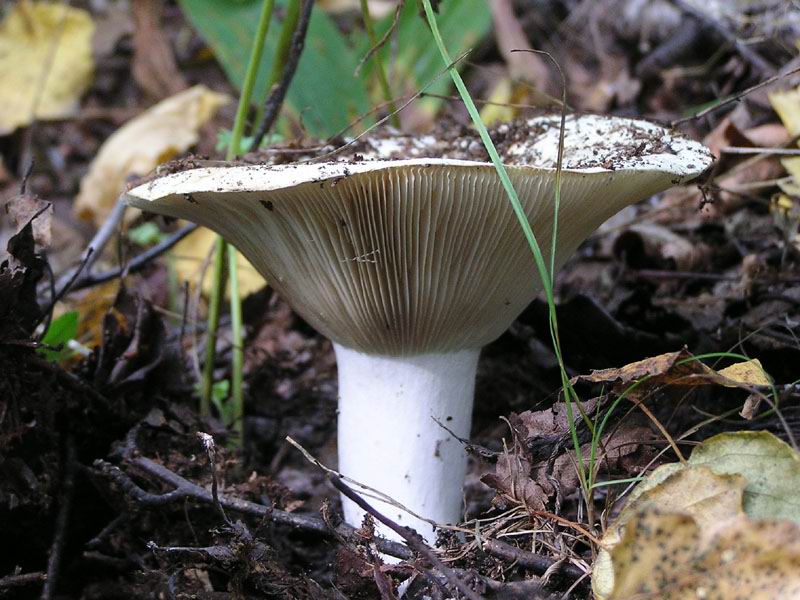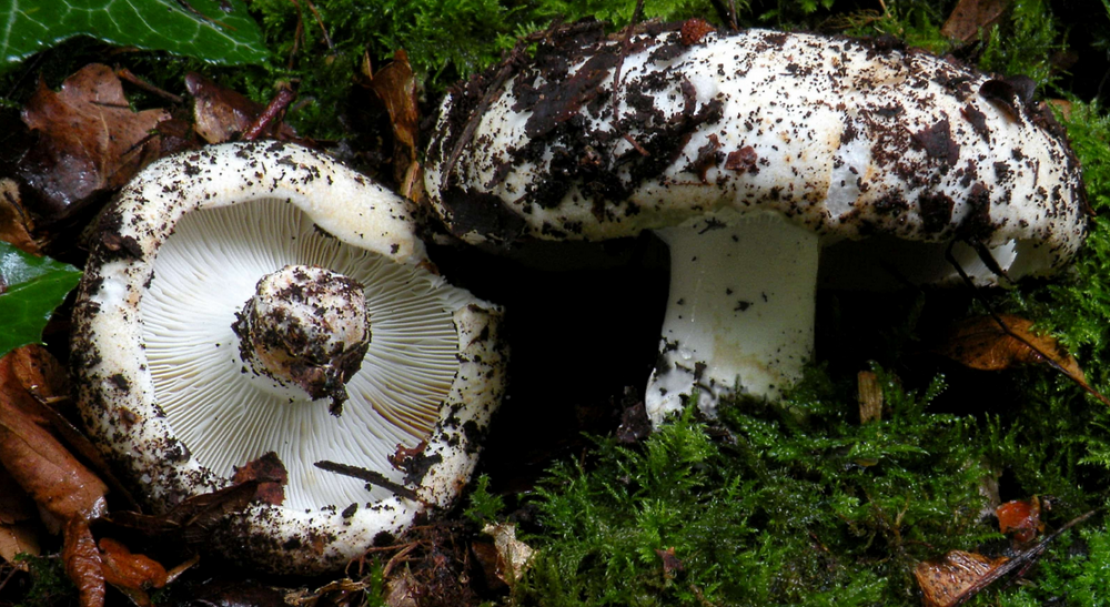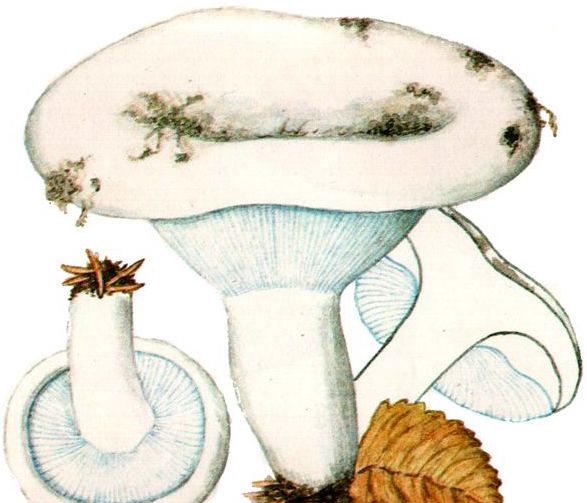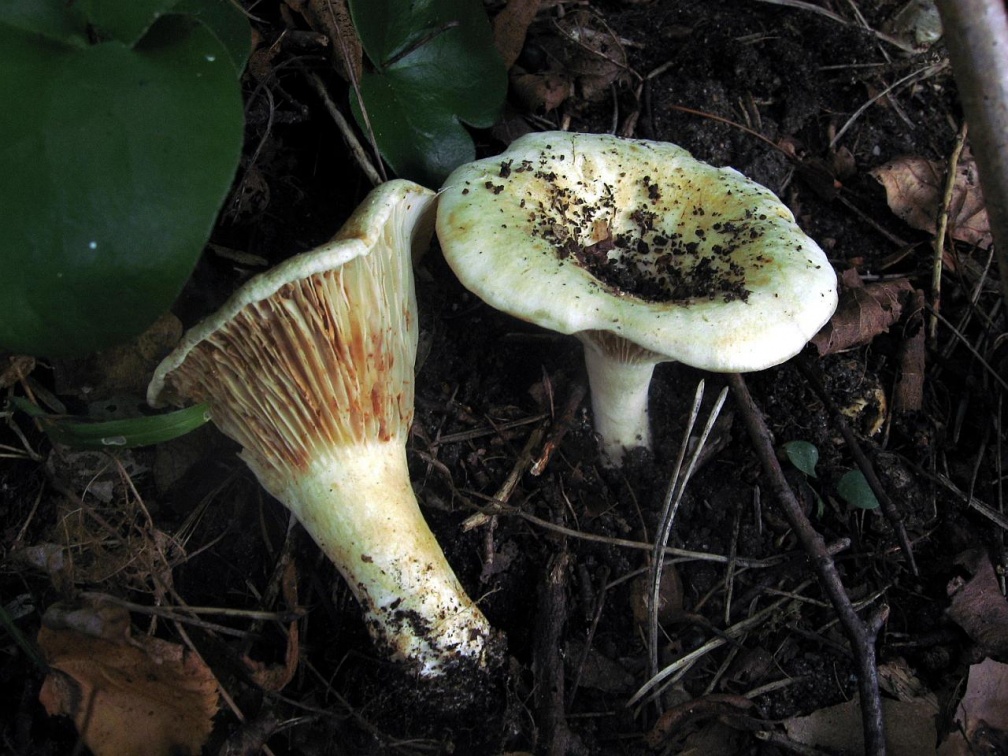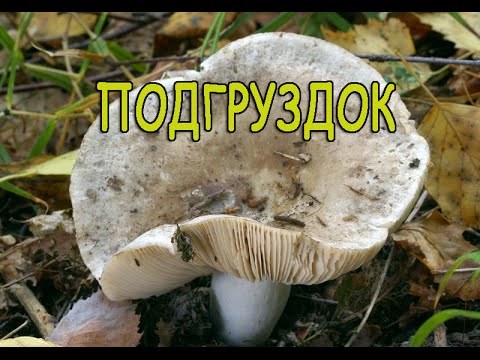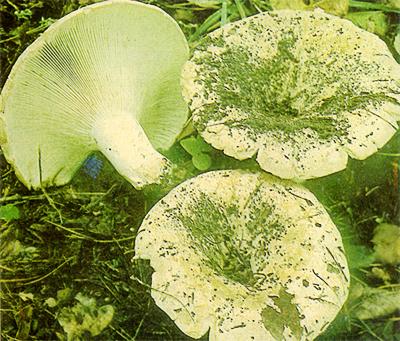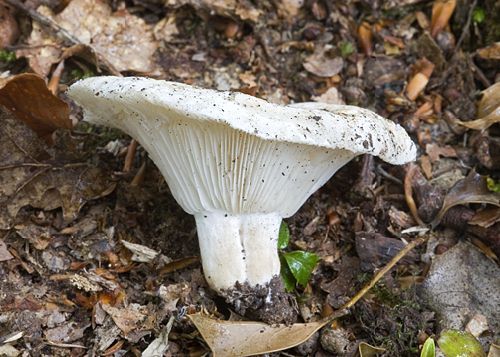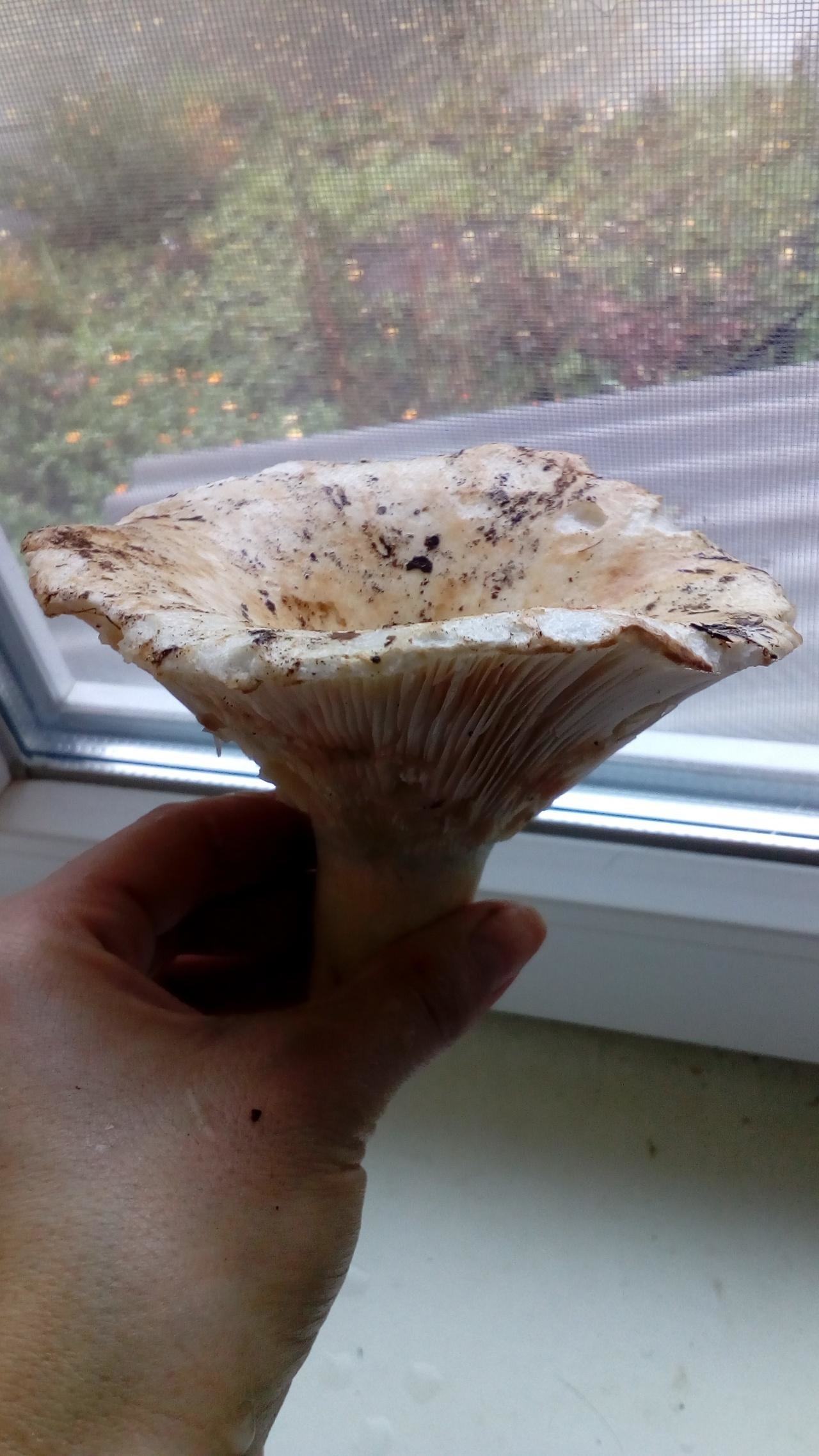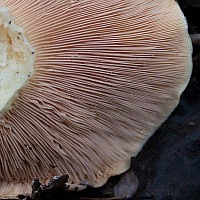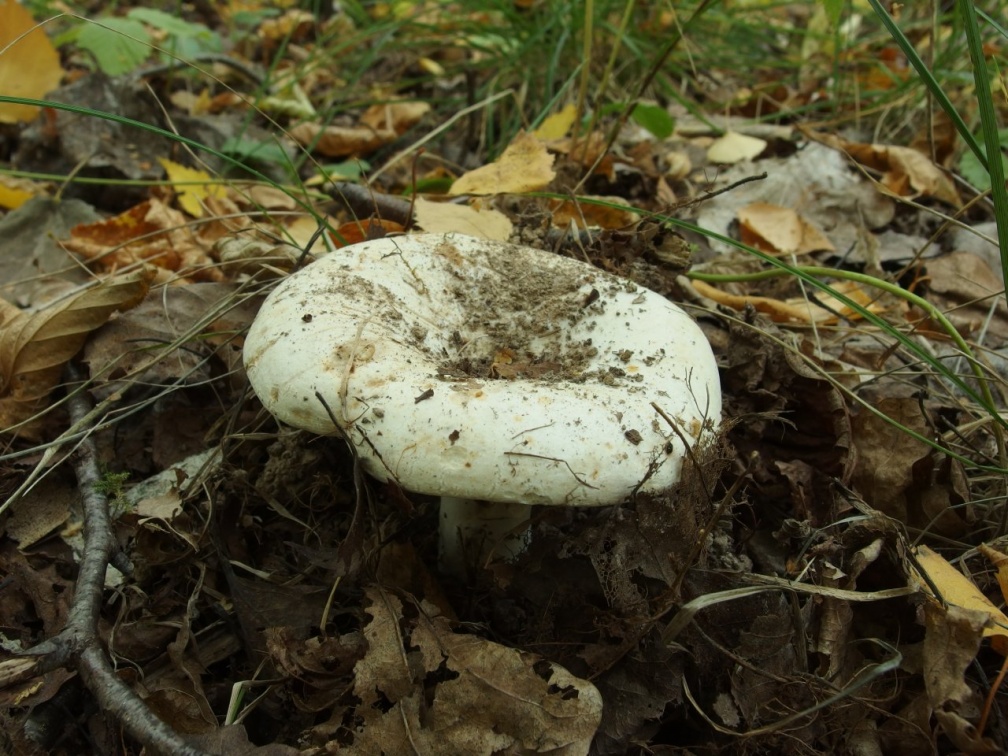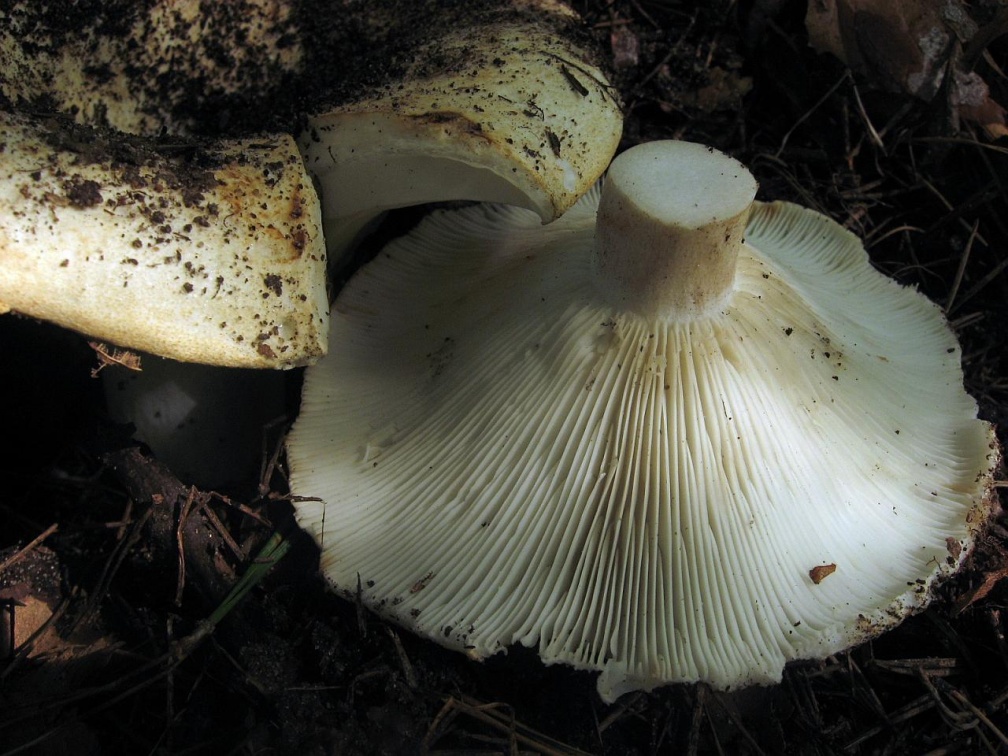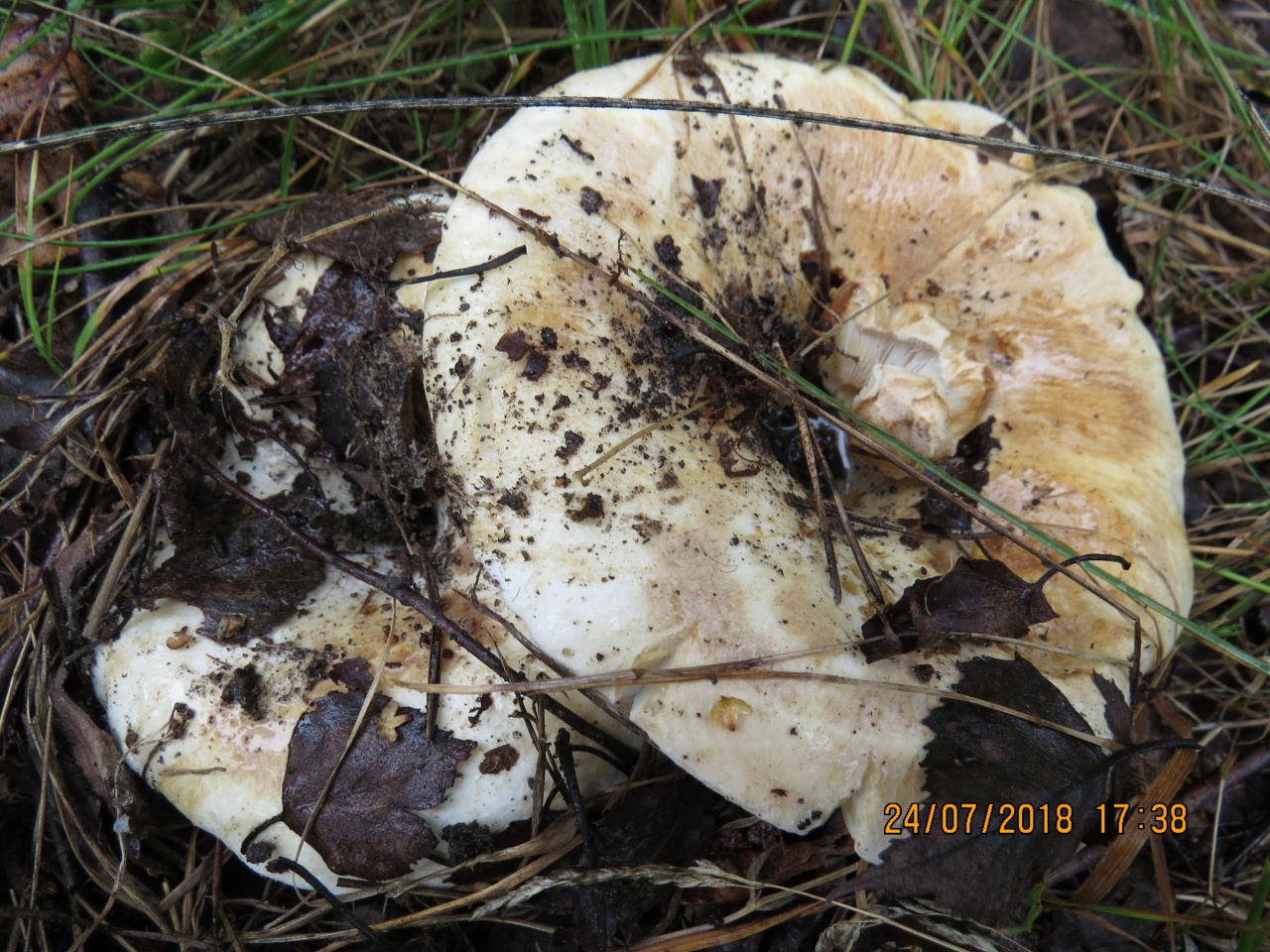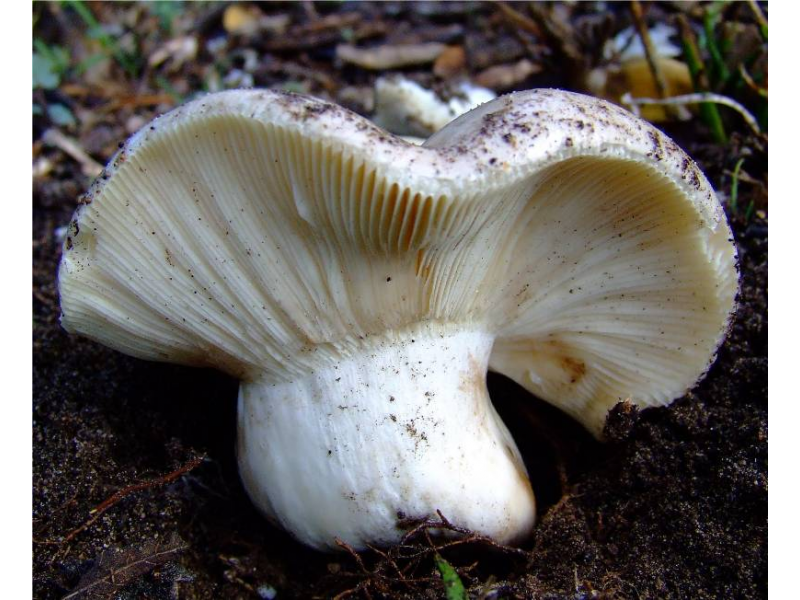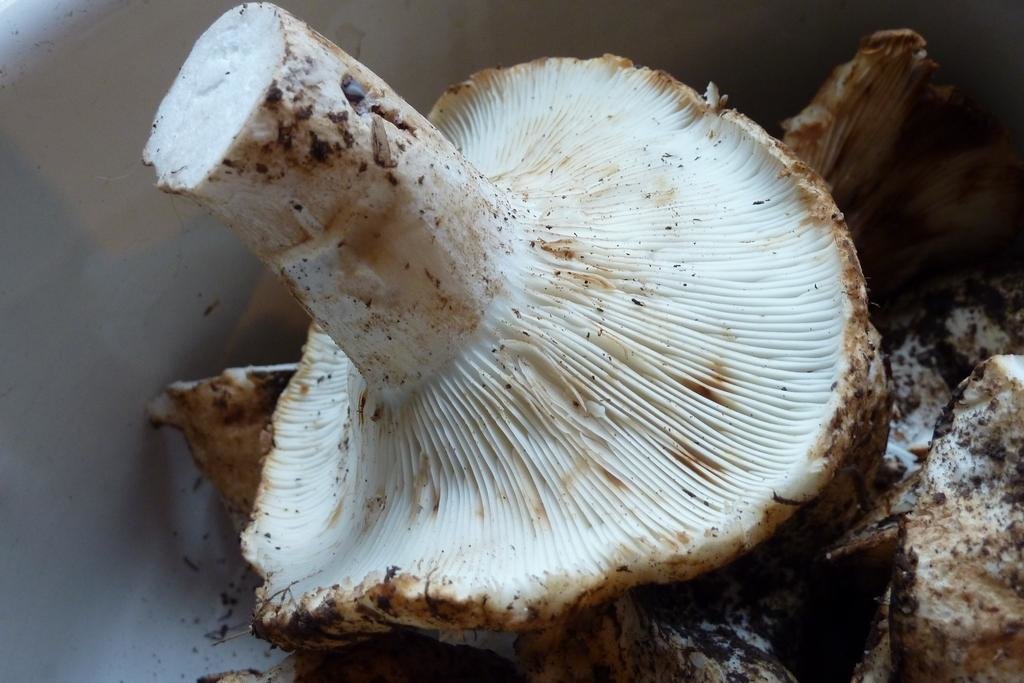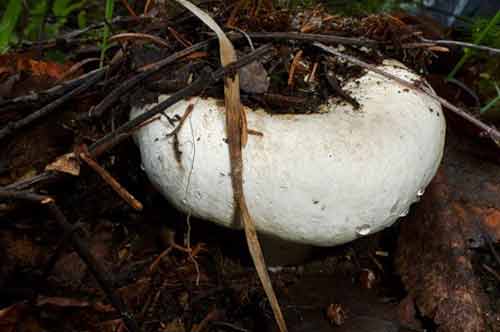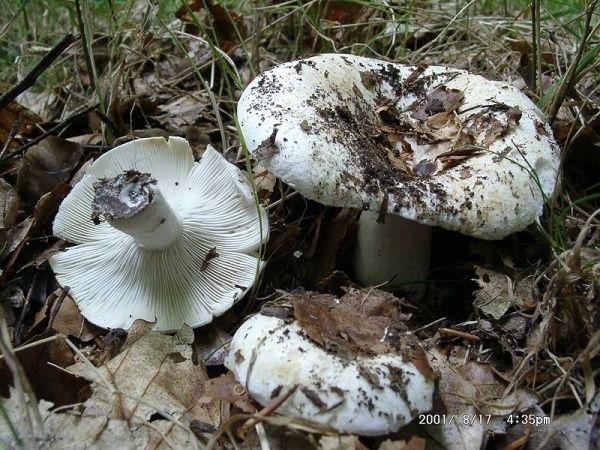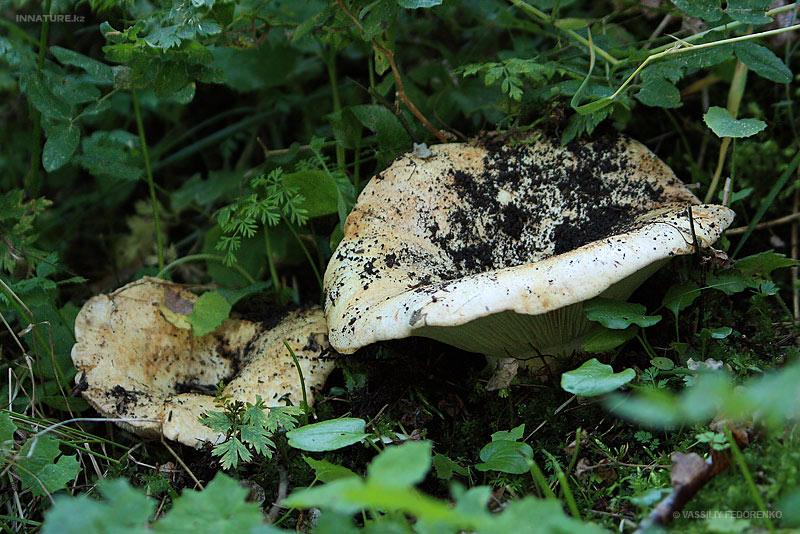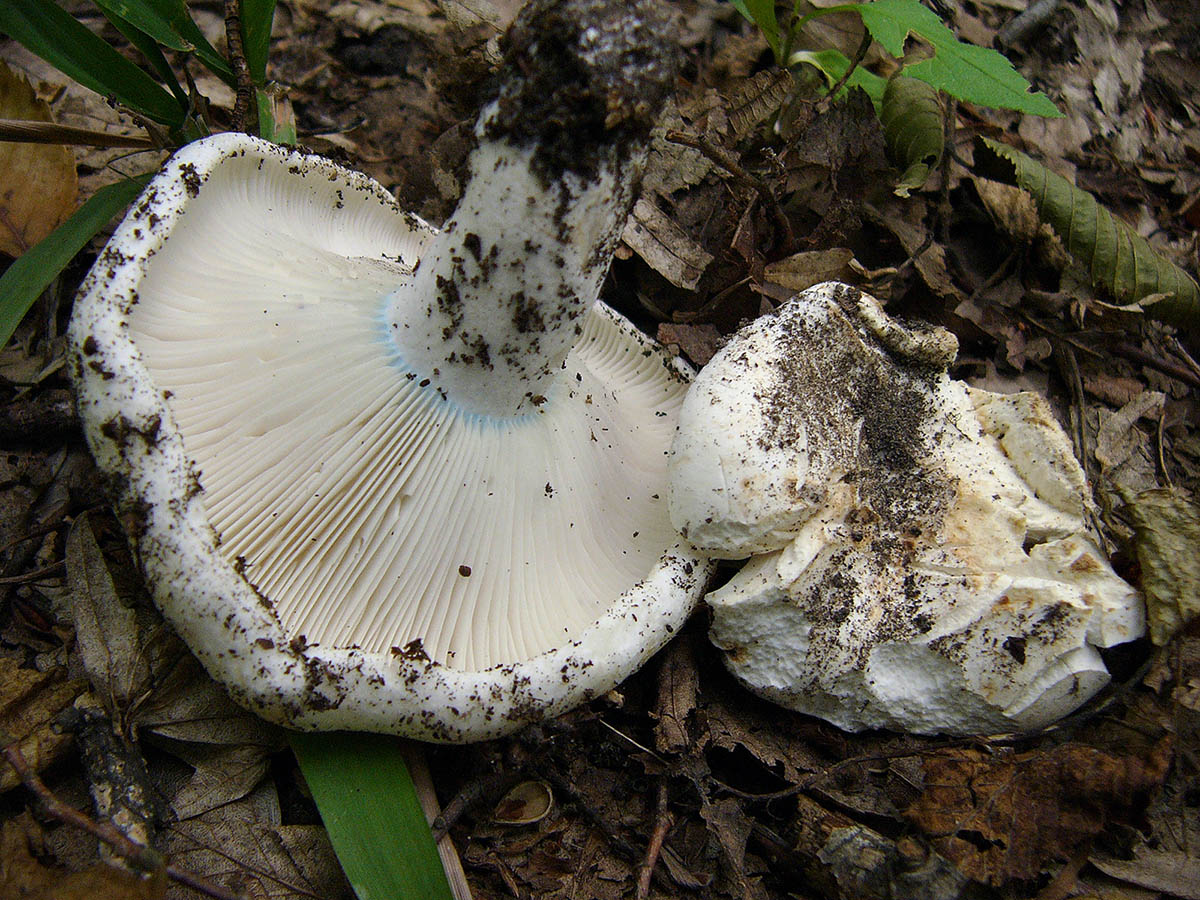Gifts of nature - articles: black podgruzdok
Insert-mushroom-tree synonyms Omphalia adusta (Pers.) Gray 1821
Russula nigricans var. adusta (Pers.) Barbier 1907
Agaricus adustus Pers. 1801
Russula adusta f. gigantea Britzelm. 1895
Russula subusta Burl. 1915
Etymolgia: Russula (russula) adusta (lat.adustus - scorched, charred).
The cap is 5-10 (15) cm in diameter, densely fleshy, semicircular, flat-spread, depressed in the center, as a rule, with a drooping sharp, smooth edge. The skin is adherent, slimy, naked, in dry weather shiny, umber, dirty brown-black, often with an olive tint, dark gray-brown in the center, lighter towards the edge.
Plates: adherent toothed, frequent, narrow, white, turning yellow with age and then acquiring the color of the cap, with darker brown spots.
Leg (2) 3-5 (7) x 2-3 (5) cm, cylindrical, made, firm, naked, smooth, whitish, then one tone lighter than the cap.
The pulp is dense, white, slightly pink in the air, then blackening, the taste is fresh or slightly sharp. Under the influence of FeS04, it turns pink, then turns green. The taste of the plates is soft.
Spores: from ellipsoidal to rounded, (7) 7.5-9 (10) x (6) 5-7 (8) microns, warty-fine mesh ornamentation.
Spore powder: pure white.
Basidia: 40-65 x 8-10 microns. Cystids 50-80 x 5-7 microns, cylindrical, not frequent, from sulfovanilin stained blue. The cuticle of the cap is gelatinous, consists of hairs and rare dermatocystids, which are separated at the apex.
The habitat grows in mixed and coniferous forests, in groups, often.
Season: June - September.
Distribution in Kazakhstan: quite common in the northern part of the country.
Habitat: Europe, Asia, North. America, Australia.
Edible: The mushroom is edible, but usually only used for pickling after boiling.
Types of mushrooms and their useful properties
Milk mushrooms belong to a large variety of milky mushrooms from the russula family.
Depending on the area of growth and external characteristics, they are divided into several types:
| Species name | Short description | Benefits and features |
| Real | The mushroom is white, the cap may have a yellowish tint. It stands out for its characteristic scent with fruity notes. | When soaked, the mushroom takes on a bluish tint. Can be used for pickling and pickling. The mushroom is recommended for use in pathologies in the urinary system. |
| Yellow | The mushroom has a golden yellow cap. When broken, it releases a thicker sap. The smell of the mushroom is poorly expressed. Due to its symbiosis with birch, it has a rich nutritional composition. | Before cooking, the milk must be soaked or boiled. It is consumed only in salted and pickled form. Allows you to alleviate the condition with gallstone disease. |
| Pepper | Fresh milk mushrooms are white in color and have a characteristic rye smell. When cut, it may take on a blue-green tint. | It stands out for its special pungency, therefore it is used only for pickling or pickling. And also crushed dry mushroom can replace ground pepper. Milk helps to remove stones and sand from the kidneys and gallbladder, and also relieves tuberculosis. |
| Aspen | In terms of external characteristics, it is similar to a real milk mushroom (and also has a fruity aroma), but does not change its shade when soaked. | In terms of nutritional value, the mushroom is inferior to the real milk mushroom. Used only for pickling. |
| Parchment | The mushroom has a yellowish cap. Does not change color when broken. | Milk can only be used for salting after preliminary soaking. |
| Bluish | The lump is pure white in color and may turn green at the break. Has no toadstools counterparts. | Due to the increased bitterness, the mushroom can only be salted after prolonged soaking in water with salt. |
| Black | The mushroom has a dark brown cap and a gray leg. When broken, the pulp quickly darkens. | It is used only for pickling, while it should be borne in mind that the mushroom will change color to dark blue. |
| Bluish | The mushroom has a yellow cap and leg. When cut, the flesh takes on a bright blue tint. | Milk can be used for pickling, pickling and frying (after soaking). Possesses pronounced antibacterial properties. |
| Oak | The hat has a characteristic spotted red color. | Used only for pickling after soaking. |
| Skripun | Outwardly, it is similar to a real load. But if you rub his hat, then a characteristic creak will be emitted. | Used only for salting after prolonged soaking. In this case, the pulp may acquire a blue tint. |
| Podgruzdok | This is a type of russula. Hats can be white or black. A distinctive feature of the present milk mushroom is the absence of milky juice. | Can be used to prepare a wide variety of dishes without soaking. |
When collecting mushrooms, it is important to be able to distinguish milk mushrooms not only from toadstools, but also by type, since they differ in taste and method of primary processing.
Salted and pickled milk mushrooms have an advantage over other cooking methods as they have the following effect on the body:
- restore the functioning of the digestive tract;
- help cleanse the blood vessels;
- reduce inflammation;
- have antimicrobial properties;
- are a preventive measure against the development of diabetes;
- improve the activity of the nervous system;
- prevent the development of cancers and the appearance of metastases;
- normalize the activity of the urinary system, eliminating puffiness.
It is important that salted milk mushrooms become a useful product; it must be consumed with pea porridge or with onions, seasoned with aromatic oil. A single serving should not exceed 300 g, with a frequency of no more than 3 times a week
It is recommended to collect only young mushrooms that grow from late July to early October.
How to recognize a false weight
Almost every edible mushroom has its own twin with a trick, the white milk mushroom is no exception.
To identify a false, poisonous mushroom, you need to pay attention to the following:
- The color of the pulp. The toxic fruit changes color as it ages. Young specimens of a dangerous culture are colored yellowish-red; over time, the fibrous tissue changes to a dirty pink, sometimes even with signs of "rust".
- It grows among deciduous as well as coniferous trees.
- Smell. It is difficult to call a scent the odor emitted by a false weight. It resembles a mixture of chemistry and coumarin, while after breaking the released juice does not change its texture and color.
- The skin is dryish, covered with small scales, often covered with spots.
There are such forest "gifts" dangerous, the mushroom is frankly poisonous and can cause irreparable damage to the human body.
Load and value
The well-known Valui mushroom and the lesser-known black and white podgruzdok belong to the russula genus. They are characterized by a fragile leg. They are usually collected a little, since more valuable mushrooms are always found in the forest. The same mushrooms are conditionally edible. They are salted, less often pickled, but must be pre-soaked in cold water to destroy bitterness or boiled.
Podgruzdok black
This mushroom is also called black russula. It is found in all forests, especially in deciduous ones, it grows all summer from June to October in groups.
The cap is up to 15 cm in diameter, in a young mushroom it is convex, in a mature one it is depressed, with curved edges, dirty gray, later brown or black, sticky. The pulp is white, brittle, without milky juice, turns red at the break, then turns brown and finally turns black. The mushroom is very similar to the milk mushroom, although it belongs to the genus russula.
Black differs from all podgruzdok podgruzdok in that it does not have milky juice. The plates are adherent to the pedicle or descending, white, darken from pressure. The leg is up to 5 cm long, 2.5–3 cm thick, smooth, dense, of the same color as the cap. These fungi are severely damaged by insects.
Mushroom little-known, edible, 3rd category, eaten boiled and salted, turns black when salted.
Valuy
It grows in deciduous and mixed forests from July to October, occurs frequently and abundantly, and is one of the most common mushrooms in our forest zone.
The cap of a young mushroom is spherical, tightly attached to the stem, later straightens and becomes flatter, up to 8–15 cm in diameter, with a ribbed-striped edge, buffy-yellow or yellow-brown, very slippery in wet weather, and shiny in dry weather. The skin peels off easily. The pulp is dense, white, yellowish in old mushrooms, very bitter, with an unpleasant odor. The plates are adherent, in young mushrooms are white, in mature ones they are yellow or rusty-yellow with brownish spots and with droplets of transparent liquid. The leg is up to 10 cm long, up to 3 cm thick, sometimes thickened in the middle, white, loose, hollow.
Mushroom conditionally edible, 3rd category. After boiling, it is suitable for pickling. It is recommended to collect young mushrooms with an unopened cap.
Podgruzdok white
Often and quite abundantly found in coniferous and deciduous forests, it grows mainly under birch and aspen trees from July to October, it differs from all mushrooms in that it does not have milky sap. The hat is the same as that of a real breast, only its edges are not fringed, and on top it is always dry and often with adhered earth, up to 20 cm in diameter, matte, white, sometimes with yellow-brown spots. The pulp is white, dense, does not change color at the break. Descending plates, frequent, thin, bluish-white. The leg is white, in a young mushroom it is even, solid, later it becomes hollow.
Conditionally edible mushroom, 2nd category, it is salted and pickled, but pre-soaked.
Hot salting
- Rinse the mushrooms out of debris and soak in clean, cold water for at least 6 hours.
- Boil the fruit bodies in boiling water (15-20 minutes) over low heat.
- Drain off excess liquid, place the product in a colander and wait for the water to drain as much as possible.
- Determine the appropriate storage capacity. It is necessary to transfer the mushrooms into it, after which - sprinkle them with spices, a sufficient amount of salt.
- Next, the dish is covered with a plate or cloth, pressed down by oppression.
It remains to put the dish in the refrigerator or a cool place. After two weeks, the snack will be ready, and during the specified period it is recommended to stir the contents of the container every few days.
Podgruzdok black white and blackening: description of the mushroom and what a dry milk mushroom looks like in the photo
Active growth requires a lot of light and little heat. This mushroom grows in huge quantities in deciduous and mixed forests of the middle zone of our country. Usually, its mycelium dislocations are located near aspens and birches. It is these trees that create the most favorable conditions for their existence.
Podgruzdok popularly has a simpler name. This is a dry lump. It is not by chance that the mushroom is called that. In from common mushrooms, they are never covered with mucus and do not become wet. The surface of their caps is always dry and slightly rough to the touch.
A regular load looks like this. This is a fairly strong cap with edges bent inward and up to 20 cm in diameter. The upper surface of the cap is matte white with yellowish blotches. During the growth process, the fungus is prone to cracking. A characteristic feature is the absence of milky juice on the cut of the stem and cap. Podgruzdok or dry lump belongs to the second category of edibility. It can be used for salting and pickling without first soaking in water
Podgruzdod black or black
From the beginning of July to the very end of October, the coniferous and deciduous forests of our country can delight you with a rich harvest of another type of dry milk mushroom. This is a black load. It is also called black russula. And this is no coincidence. Outwardly, the black podgruzdok really resembles a russula. The hat is up to 15 cm in diameter and has a glossy dark blue, almost black surface. There is no milky juice.
Black podgruzdok can be eaten boiled, fried and salted. Does not require soaking before direct use.
Podgruzdok porcini and mushroom rusk
Podgruzdok porcini and mushroom rusk are the names of the same specimen. This is a type of mushrooms and lamellar mushrooms that grow in large numbers in bright places in deciduous forests. They can be eaten without boiling or steeping. They are distinguished by the absence of bitterness and unpleasant taste. belong to the category of little-known. But don't neglect them. They contain a fairly large amount of protein and various active substances that improve digestion. Dry milk mushrooms make an excellent powder for sauces and seasonings.
What does a blackening load look like
Blackening podgruzdok is another type of lamellar mushrooms that are found by mushroom pickers in mixed and deciduous forests and at the same time go unnoticed. Many confuse them with poisonous and inedible due to their unsightly appearance. But let's try to figure it out.
There is a certain opinion among mushroom pickers that the edible lamellar must necessarily produce milky juice. Dry milk has no milky juice. And this does not mean that it is poisonous. The blackening podgruzdok in appearance resembles a real lump. But unlike him, over time, his cap and leg begin to turn black. Older specimens are almost black in all parts.
Black podgruzdok, Russula adusta
Hat: Diameter 7-15 cm, first flat-convex, then flat-concave, at first white-grayish, then unevenly colored, dark olive-brown, black. The pulp is grayish, thick, brittle, at the break it first turns red, then turns gray. The taste is sweetish.
Hymenophore: The plates are at first white, subsequently grayish, darken when pressed, adherent.
Spore powder: White.
Leg: Relatively short and thick, 3-7 cm in length, up to 3 cm in thickness, cylindrical, solid, of the same color with a cap or lighter, often with dark spots, darkens when pressed.
Spreading: Russula adusta is found in various forests from July to October, in good seasons - in large groups. Often it leads a semi-underground way of life, opening only in old age.
Similar species: There are enough similar mushrooms with gray caps and blackening pulp in the genus of russula. The differences are pretty minor. For example, blackening podgruzdok (Russula nigricans) - the pulp, upon contact with air, undergoes the same metamorphoses (from pink to dark gray), but rare plates. Russula albonigra turns black radically, without any flirting with the red part of the spectrum. R. acrifolia and R. densifolia have a distinctly bitter flesh and change color much faster. It is curious that in good conditions for themselves, black loadings of different types can grow intermixed, which gives a novice enthusiast-classifier especially exquisite pleasure.
Edibility: It is considered a good edible mushroom. Doesn't require any special measures.
Author's notes: As you certainly already know, Russula adusta is the record holder for worm attendance. (Only closely related species of black podloads can argue with him - or with her -) In our area, he is often found, especially at the beginning of fruiting, from mid-July to mid-August, but I can say without exaggeration: I still do not know what it tastes like. Once I found two (!) Completely non-wormy mushrooms in a very damp, dark and completely non-mushroom deciduous forest in the Tula region, but it so happened that already at the stage of preparation, these specimens were mixed with the rest of the mushrooms, and I could not find out that the same is found in this wonderful mushroom the larvae of mushroom flies.
Black podgruzdok differs from other blackening russules with difficulty. The frequency of the plates is one of the signs that make it possible to persuade the mushroom to the species Russula adusta. One, but not the only one.
The mushroom, by the will of fate, has spent most of its life under a thick layer of litter, crawls out like this.And it's good if it comes out - a significant part of the black pods will never see the light of day. However, why light - mushroom flies will find it by smell.
It is possible that mushroom flies are guided, among other things, by aesthetic flies - even for a person who represents, in general, what is going on inside, this mushroom looks more than appetizing.
Description of white loading
The cap of a dry weight is first convex with the edges tucked down, then it becomes funnel-shaped, depressed. Its diameter is 7-20 centimeters at different stages of growth. The color of the cap is pure white, sometimes red-brown or brown-yellow spots may be present.
At first, the surface of the cap is thin, over time it becomes bare, and lumps of earth often stick to it. In dry weather, the cap cracks.
There are frequent, rather thin plates under the cap. The color of the plates is white, while there is a bluish or turquoise tint, a greenish metallic tint can be observed. The pulp is firm but fragile. The color of the pulp is white, it does not change at the break. The pulp is not pungent, but the plates are very pungent. The taste of the pulp is insipid, and the aroma is similar to the smell of lactarius.

The leg is strong, relatively short and thick. Its length is 2-5 centimeters, and its girth is no more than 1-2 centimeters. The color of the leg is white, often with age it becomes brownish with brown spots of irregular shape. In the upper part, the leg is narrower, slightly bluish. In overripe specimens, the legs become hollow.
Places of growth of dry mushrooms
Dry milk mushrooms are common throughout the forest territory of the Russian Federation. These fungi form mycorrhiza with beech, birch, aspen, oak, pine, spruce and alder.
White podgruzdki are quite abundant in birch, mixed, coniferous forests, aspen forests. They can grow in mountainous areas. Dry milk mushrooms bear fruit from June to November.

Macroscopic description of white loading
Basidiocarps (fruiting bodies) of Russula delica do not seem to want to leave the mycelium, and often fungi are found half-buried and sometimes growing hypogenically. As a result, the caps, during the growth of the fungus, often capture the surrounding leaf debris and soil with rough surfaces.
p, blockquote 3,0,0,0,0 ->
Hat
White podgruzdok - hat
Has a noticeable size, from 8 to 20 cm in diameter. At first, it is convex with a central depression, rapidly develops into a funnel. Cuticle is white, creamy white, with buffy yellowish tones and more prominent spots on mature specimens. The flesh of the cap is dry, thin, dull, difficult to separate, smooth in juveniles and rough in mature specimens. The edge of the cap is spiral, lobed. The hat is often strewn with traces of dirt, grass and leaves.
p, blockquote 4,0,1,0,0 ->
Hymenophore
p, blockquote 5,0,0,0,0 ->
The gills descend to the pedicle, brittle, wide, ventricular, moderately dense, with lamellas. Their color is white, slightly creamy, the plates are slightly ocher colored when damaged. Sometimes they secrete clear sap like water droplets.
p, blockquote 6,0,0,0,0 ->
Leg
p, blockquote 7,0,0,0,0 ->
Cylindrical, short in relation to the diameter of the cap, from 3 to 7 in length and from 2 to 3 cm in diameter, hard, brittle, continuous, without a central cavity. The color of the leg is white, cream-colored at maturity.
p, blockquote 8,0,0,0,0 ->
Mushroom flesh
Dense, brittle, white, with time acquiring a yellowish tint. Her smell is fruity in young specimens and somewhat unpleasant, fishy in overripe mushrooms. The sweet taste becomes somewhat spicy, especially in the gills, when ripe. People find the white flavor to be spicy, spicy.
p, blockquote 9,1,0,0,0 ->
Chemical reaction: Ferrous sulfate changes the color of the flesh to orange.
p, blockquote 10,0,0,0,0 ->
Spores: creamy white, ovoid, with a delicate warty pattern, 8.5-11 x 7-9.5 microns.
p, blockquote 11,0,0,0,0 ->
Contraindications
Millers are digested for a long time and create a load on the stomach, therefore, among the contraindications to their use, stomach ulcers and gastritis can be distinguished. Also, milkmen are contraindicated as a food for children under the age of seven. Untreated and expired mushrooms can trigger botulism.
Milk mushrooms are delicious gourmet mushrooms that grow in deciduous, mixed, and pine forests, classified into edible and inedible varieties.Due to the high content of lactic acid, they taste bitter, so they must be cleaned of caustic liquid before cooking. Among the useful properties, nutritional and medicinal ones are distinguished. The composition of these mushrooms is rich in protein and vitamins. Millers are contraindicated for use unrefined.
Evaluation of the edibility of whites
These mushrooms can be fried, pickled and made into soups. Dry milk mushrooms are pickled with or without boiling. In certain regions, these mushrooms are valued more than other species, including milk mushrooms.
Similar species
• Short-legged russula, like white podgruzdok, is a rare mushroom. It only grows in North America;
• Podgruzdok greenish lamellar prefers to grow in the depths of the forest, in shady places. This mushroom can be recognized by its bluish plates;
• False load white settles only under oak trees. His cap is first convex, and then concave, yellow, and the plates are bluish-green;
• Violin differs from white loading by the presence of milky juice.

Medicinal properties of white loading
An alcoholic solution from fresh fruit bodies has antitumor activity. It is 100% effective against Ehrlich's carcinoma and 90% against sarcoma-180.
Related species
Black podgruzdok is an edible mushroom. In certain areas, it is called the black russula. His hat is convex-outstretched, depressed in the middle. The color of the cap is fawn or grayish, with age it turns brown. The surface of the cap is sticky. The leg is cylindrical, dense, of the same color as the cap. If the leg is touched, it turns black. The pulp is sweetish, with a moldy smell, not spicy, at the break it turns red.
Black pods grow under the pines. They choose acidic soils. Collect black podgruzdi from July to October. They are not abundant. These are edible mushrooms, but of the 4th category, they are suitable for pickling.

The podgruzdok is a black and white edible mushroom, but its taste is bland. It has a cap with a diameter of up to 5 centimeters, at first it is convex, and then it becomes funnel-shaped. The surface of the cap is whitish, in the center it becomes dirty gray with age. When pressed, the cap turns black. The stem is cylindrical, strong, full, whitish, with time black spots appear on it. The pulp is dense, white in color, it turns brown in the air. The pulp tastes mint, and the smell is fruity.
White and black pods grow in Eurasia and North America. They can settle in deciduous forests and conifers. These mushrooms enter into beneficial alliances with pines and birches.
How to cook loadings. Recipe for loading. How to salt the load. How to distinguish overloads. How to clean loadings. How long does it take to cook the load.
How to salt pods in a quick way
How to salt the load 1. Rinse the mushrooms well from dirt and needles. It is necessary to rinse with strong pressure with cold water. If the mushrooms have a yellowed layer, it must be removed using special or toothbrushes, carefully rubbing the dirty area. If the load is old, then the yellowed areas should be cut off with a knife. 2. Place the pods in a saucepan, cover with water, add 1 teaspoon of salt and put on moderate heat. 3. Boil the mushrooms for 20 minutes and add a pinch of citric acid. 4. Remove from heat and cool the load. 5. Prepare the brine: add 2 tablespoons of salt to 1 liter of water. 6. Pour brine into the mushrooms, transfer to an airtight container and put in cold running water. 7. When the mushrooms have cooled, they are ready to eat.
Fusofacts
- Loads grow in deciduous and mixed forests, in sandy-soddy soil. As a rule, myceliums are located near birches, aspens, wild apple trees and pears.
- A lot of light and a little warmth are required for the active growth of loads. They appear in June and can be harvested until late autumn - mid-November, until the air temperature is low.
- Large families' loads are growing. Although they need light, they hide under foliage and ground.To collect them, sometimes you have to dig the soil.
- Unlike milk mushrooms, podgruzdki can be fried, while it is possible without soaking. You can also cook soups from them. But most often they are consumed in a salted form.
- Mushrooms of this type are bitter, therefore, before cooking, you need to carry out a preliminary long soaking in water. The loads are soaked in water for 3 days, the water is changed every 24 hours
It is important to use running cold water, but if you use warm water, then the mushrooms will turn black
- The peculiarity of podloads is that when they grow, lumps of soil are always formed on the cap, which are difficult to remove. Clean well after soaking in cold water. You can use a toothbrush to gently remove needles and dirt. Its villi will remove even small particles of dirt.
- Before you salt, the podgruzdki must be boiled - this will help get rid of the bitterness of the mushroom. It will be enough that the podgruzdki boil for 20 minutes in salted water.
- If the load is too salty when boiling mushrooms, you need to place them in cold water and stand for 10 minutes.
Places of growth of black russula.
Mostly black russula grow in pine forests. They settle in groups. Chernushki grow under the pines. Fruiting of nigella is observed from July to October. Black russula are common in mixed, deciduous forests and conifers.
Evaluation of the edibility of nigella.
Black russula are edible, but they are not very tasty, they are classified in the 4th category. During salting, they turn black. Their taste is sweetish, pleasant. They are also boiled and stewed. It is recommended to soak the russula before cooking. These mushrooms go well with fried and stewed vegetables. And salted russula are considered a delicacy. Salted russula are ready in a day. They go well with other types of mushrooms.
Fried russula taste like many other types. Black podgruzddki can be served as a separate dish or with side dishes. Some connoisseurs make chops from them. But it is not recommended to add russula to soups, as they give the dish a bitter taste.
Properties and benefits of black pads.
The composition of black russula contains vitamins B2 and PP, as well as carbohydrates, fats and proteins. These mushrooms are antibacterial. The calorie content of black russula is low, so they are suitable for dietary nutrition, but at the same time they are nutritious and well satisfy the feeling of hunger, without creating discomfort in the stomach.
Russula are indicated for people with gastrointestinal diseases. They help with blood clots and prevent the risk of blood clots. In addition, russula curdled milk, creating a healing fermented milk product from it. Such a product is useful for people with cardiovascular diseases.
Related species.
The russula pink is a conditionally edible relative of the black podgruzka. Her hat is semi-circular. Its surface is smooth, dry, velvety. The color of the cap can be dark pink or red. The leg is cylindrical, thick, white with a pink tint. The pulp is firm but fragile.
Pink russula grow in deciduous forests, rarely found in conifers. These mushrooms can settle in mountainous regions. Fruiting of pink russula is observed in summer and autumn.
Turkish russula is an edible mushroom. The shape of the cap is convex, flattened or depressed. Its color is most often purple, but it can be gray-purple. The stem can be cylindrical or clavate, white or pink in color. The pulp is dense, white, with a sweetish taste and pleasant smell.
These mushrooms grow in European coniferous forests. Turkish russula settle under spruce and fir trees. They grow singly or in small groups.
Evaluation of taste and recipes
Officially, blackening podgruzdok belongs to the 4th category, that is, it is considered suitable only for salting.It is worth collecting it exclusively at a young age - over time, the mushrooms become tough, moreover, they often become wormy.
In addition to salting, podgruzdki is also used in boiled and fried form. Below are the simplest recipes.
Primary processing
First, the mushrooms are soaked in water. It will take from 5 hours to a day. Sometimes it is recommended to soak the load for 3-5 days, changing the water daily. With the liquid, the pungent taste of the cap will go away, and it will become much easier to clean the pods, to which the leaves and needles usually stick. To drive out worms that may have lurked in the mushroom and went unnoticed, the water can be slightly salted.
Then the mushrooms are cleaned. Use a knife to remove the skin from the cap and remove any wormholes and areas that are in doubt, such as yellowed ones. If dirt is difficult to remove, use a clean toothbrush.
Frying
To prepare the taste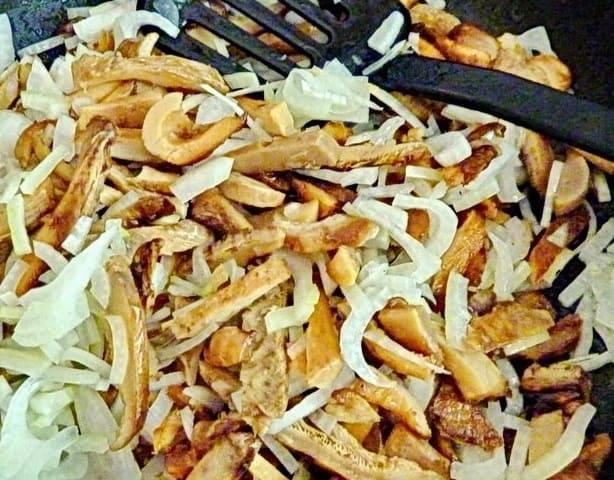 new mushroom treat, take the following ingredients:
new mushroom treat, take the following ingredients:
- 1 medium onion;
- 400-500 grams of mushrooms;
- butter or vegetable oil for frying;
- 1-2 cloves of garlic (to taste).
Cooking process:
- Chop the onion finely and fry in oil until translucent.
- Chop the boiled podgruzdki into slices and throw into the pan with the onion.
- Fry for about 15 minutes, stirring occasionally to prevent the mushrooms from burning.
- If desired, cut the garlic into thin slices or pass it through a press and add to the dish while frying.
Salting
The podgruzdki are salted both hot and cold. For the hot method, you will need the following components:
- 5 kg of mushrooms;
- 1 liter of water;
- 2 tablespoons of salt;
- spices (dill, garlic, currant leaves, cherries and horseradish, pepper) to taste.
Cooking method:
- Soak and peel the mushrooms as described above.
- Boil in salted water for about 20 minutes.
- Discard the mushrooms in a colander and cover them with cold water.
- To make the brine, boil the water and salt.
- Put dill, garlic, currant leaves, cherries and horseradish, pepper on the bottom of sterile jars, then put the podgruzdki and fill them with brine.
- Close the jars with sterile plastic lids and place them in the refrigerator or cellar. After a few days, the appetizer can be served at the table.
For the cold method, you will need the following ingredients:
- 5 kg of mushrooms;
- 250 g of salt;
- spices as for the hot method.
Cooking method:
- Soak the load for 24 hours. Remember to change the water from time to time. When ready for further processing, the cap of the mushroom should bend, not break.
- Put spices at the bottom of an enamel bucket or tub, then mushrooms in layers of 5-6 cm.
- Sprinkle each layer with salt.
- Spread the spices on top and place the load. As the mushrooms settle, new ones can be added.
- The podgruzdki will be ready in about a month.
Although blackening is considered a conditionally edible mushroom, do not neglect it! It is difficult to confuse it with dangerous toadstools; it is good both in salted and fried form. Just don't forget to soak and clean the pods well, and they will thank you with excellent taste.

